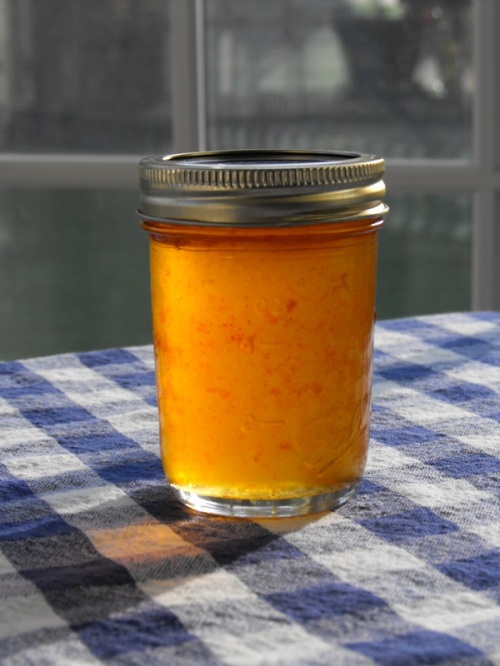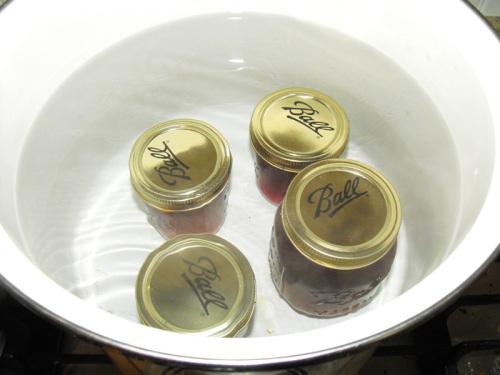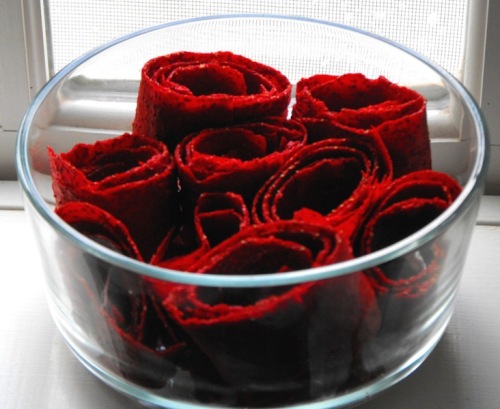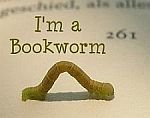I’ve got a bunch of apples that I’d like to can. Of course I’m going to make a ton of unsweetened applesauce, but I’d also like to can apple pie filling or apple slices. Anybody have a good recipe?
Tag Archives: preserving
Reduced-Sugar Cinnamon Cider Jelly

This is the reduced-sugar version of my Cinnamon Cider Jelly. The only real difference I see is that the no-sugar-needed pectin makes a cloudy jelly and the regular pectin makes a crystal clear jelly. You can use regular sugar, as I have, or splenda or honey. Just follow the directions on the no-sugar-needed pectin to decide how much of the alternative sweetener to add. In a fancy canning jar like the one above, these make great holiday gifts.
- 4 cups apple cider
- 1 package no-sugar-needed pectin
- 1 tsp butter (optional, reduces foaming)
- 0-3 cups sugar (I used 2 cups)
- 1/2 tsp cinnamon
- Sterilize jars in a boiling water canner for 10 minutes. Ladle some of the boiling water over the lids in a bowl. Let them sit in the hot water until ready to use.
- Pour the cider into a large pot and slowly stir in the no-sugar-needed pectin. Add the butter. Bring the mixture to a rapid boil that cannot be stirred down.
- Add the sugar and cinnamon and stir to combine. Bring to a boil and boil hard for 1 minute, stirring constantly. Remove from heat and skim the foam.
- Fill jars, leaving 1/4 inch headspace. Process for 10 minutes. Makes 3-5 half-pints, depending on how much sugar you add.
Filed under Food, Living from Scratch, Local Agriculture, Recipes, Sustainable Living
Cinnamon Cider Jelly
I’ve decided that this week is going to be Apple Week, with all posts about apples!
When I was a child, my family made cider to sell in our farm market from apples in our orchard. My mom, brothers and I would help bottle the cider while my dad, uncle and grandfather made cider using the fancy press. Later on, another uncle would come pick up the pumice (waste apple flesh) to feed to his cows. It’s funny to think of it now, because I really hated cider. Back then, bottling cider meant sticky hands and clothes, noisy equipment, and bees… bees everywhere, though I don’t remember ever getting stung. Today when I opened my gallon of cider to make this recipe, the smell of the cider brought me right back to the cider mill. I can look back on it fondly now, laughing at the stickiness, and realizing just how lucky I was to help make cider with my family. I’ll think of it every time I use this jelly.

This is the first time I’ve tried this recipe, but it’s been lingering in my mind since last fall. I love jelly, but I hate the hours it takes to prep the fruit, cook and strain it. Since this recipe starts with cider, someone else has done all the work and those steps are eliminated. These days, it’s pretty rare to find unpasteurized cider around here, since fears of E. coli abound. However, if you have a trusted farm stand who does not use drops (apples that fell on the ground) there’s really no chance of E. coli being in the cider. If you’ve never tried unpasteurized cider, you’re missing out on a distince flavor, but keep in mind that it won’t keep as long as pasteurized cider. This recipe will work with either unpasteurized or pasteurized cider. This is a traditional jelly recipe, but I’ve also got a reduced-sugar version.
- 5 cups apple cider
- 1 package powdered pectin
- 1 tsp butter
- 1/2 tsp cinnamon
- 7 cups sugar
- Sterilize jars in a boiling water canner for 10 minutes. Ladle some of the boiling water over the lids in a bowl. Let them sit in the hot water until they’re ready to use.
- Pour the apple cider into a large pot and slowly stir in the pectin. Add the butter, and bring the mixture to a rapid boil that cannot be stirred down.
- Add the cinnamon and sugar and stir to combine. Bring to a full rolling boil and boil hard for 1 minute, stirring constantly. Turn off the heat and skim the foam.
- Fill the jars, leaving 1/4 inch headspace. Place the lids and screw on the rings, then process for 10 minutes.
For more information about making and canning jelly, read my Strawberry Jelly tutorial. Check out the reduced-sugar version!
Filed under Food, Living from Scratch, Local Agriculture, Recipes, Sustainable Living
Perfectionist
Today as I walked through my pantry, I eyed some jars of strawberry jelly and caramel apple butter, then moved them from the open shelf into a cabinet. I wouldn’t want Ed to open and eat them before I get a chance to enter them in the fair this fall.
As I was hiding the jars behind some empty jars, I realized I’m a competitive person. Not in a “keeping up with the Jones’s” kind of way. Not with material things. I just want to do my best, be the best that I can. I guess I’m a perfectionist.
Years ago when I was completing my BEST portfolio (an evaluative portfolio for all second-year teachers in the state of Connecticut), I wanted it to be the best. Not only did I want to get the highest score possible on my portfolio, I wanted it to be chosen as an exemplar, one of the best portfolios in the state. Even though I didn’t get chosen as an exemplar, I did get selected to present some tips for success to teachers the following year. That had to be good enough.
While I easily could have gotten a B on the papers I’ve worked on the last few days, that wasn’t good enough. I don’t only want an A, I want an A+. (Are you reading this, professor?) I wasn’t going to do less than my best, even if it meant spending countless hours sitting at the computer while also neglecting my responsibilities around the house (like dishes, laundry, grocery shopping, pulling weeds…). If someone was going to grade me on my housekeeping, I think I’d put in a lot more effort. Perhaps I need to institute a monthly housekeeping report card. (Yeah right).
Anyway, back to the fair. Last year, I entered my butternut squash pie in the Guilford Fair and won Best In Show. This year, I plan to enter the pie again, along with some preserves. Strawberry jelly, caramel apple butter, applesauce, canned tomatoes and canned peaches are on my mental list of entries. I want them to win blue ribbons. Red and yellow are unacceptable around here.
I’m also planning to enter my butternut squash pie in the Durham Fair this year. Durham is the unofficial state fair, and I’m going to be up against some stiff competition. But that blue rosette from Guilford last year gave me the confidence I need to try Durham. Blue is my favorite color.
Are you planning to enter anything in fairs this year?
Filed under Food, Living from Scratch, Sustainable Living
Strawberry Jelly
Note: If you have never canned before, I highly recommend Joy of Cooking: All about Canning and Preserving and the Ball Blue Book of Preserving. These books will help you learn about safe canning practices and the equipment you will need.
To me, the most important thing about making jelly successfully is following the measurements. If the measurements below don’t match the recipe on the package of pectin, follow that recipe instead to get your jelly to set properly. I’ve made jelly in the past that doesn’t “jell” and remains a liquid, and it’s mostly because I tried to sneak in more juice than the recipe calls for.

Start by crushing 4 quarts of hulled strawberries with a potato masher in a large pot. Cook for about 5 minutes.

Strain the berries using a jelly bag or cheesecloth. Let the juice drip into a bowl for an hour or more. You can save the berries to make fruit leather.

When the berries have drained, sterilize jars by boiling them in a large pot of water for 10 minutes. Let them sit in the steaming water until you are ready to use them.

Measure out 3 1/2 cups of strawberry juice. If you have extra, you can freeze ice cubes of the juice, which are especially good in lemonade.

Slowly stir in 1 package of powdered pectin, and start heating the juice over high heat.

Add 1/2 tsp butter to help keep the mixture from boiling over.

Bring the mixture to a rolling boil for 5 minutes.

Then add 4 1/2 cups of sugar, and stir to dissolve. Continue to heat the mixture over high heat.

Boil hard for 1 minute.

Skim off any foam, then ladel into the sterilized jars leaving 1/4 inch headspace. Place caps on and screw on rings. If you have a half-full jar, cap it and use it right away, storing it in the fridge.

Return jars to the hot water. Bring to a boil, and process for 10 minutes. Remove jars to a towel or cutting board and allow them to cool, undisturbed, for about a day.

Label jars and store them in a dark place. Yield: about 6 1/2-pint jars.
Related posts:
Filed under Food, Living from Scratch, Local Agriculture, Recipes, Sustainable Living






















